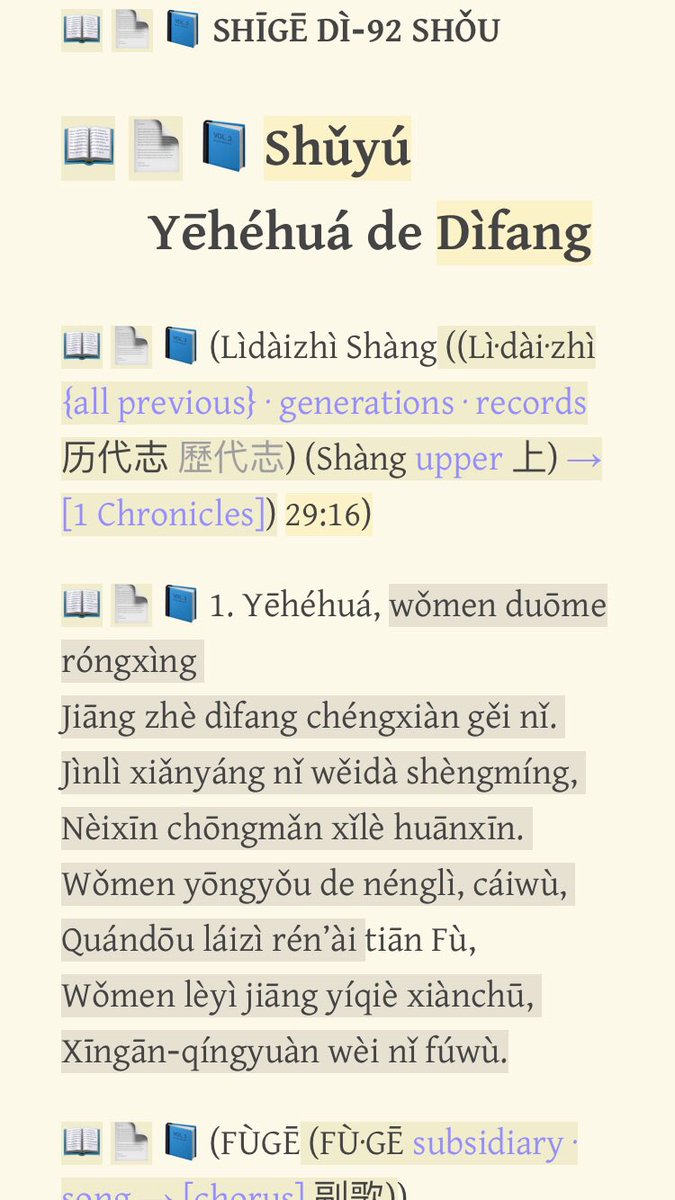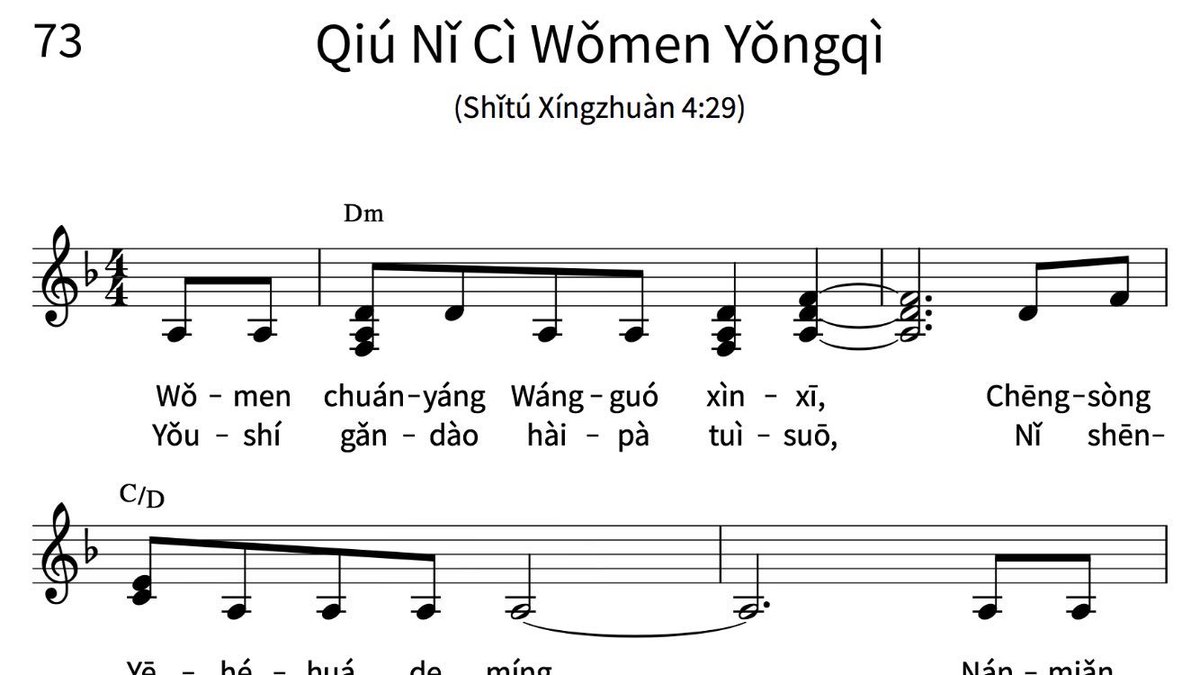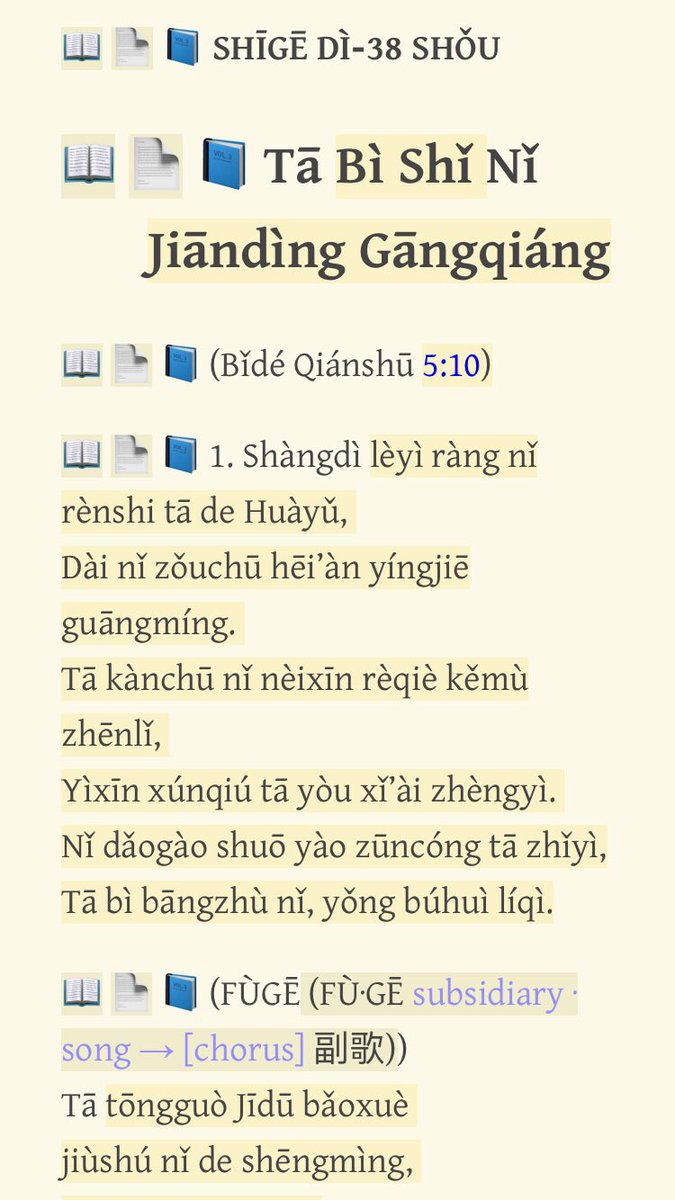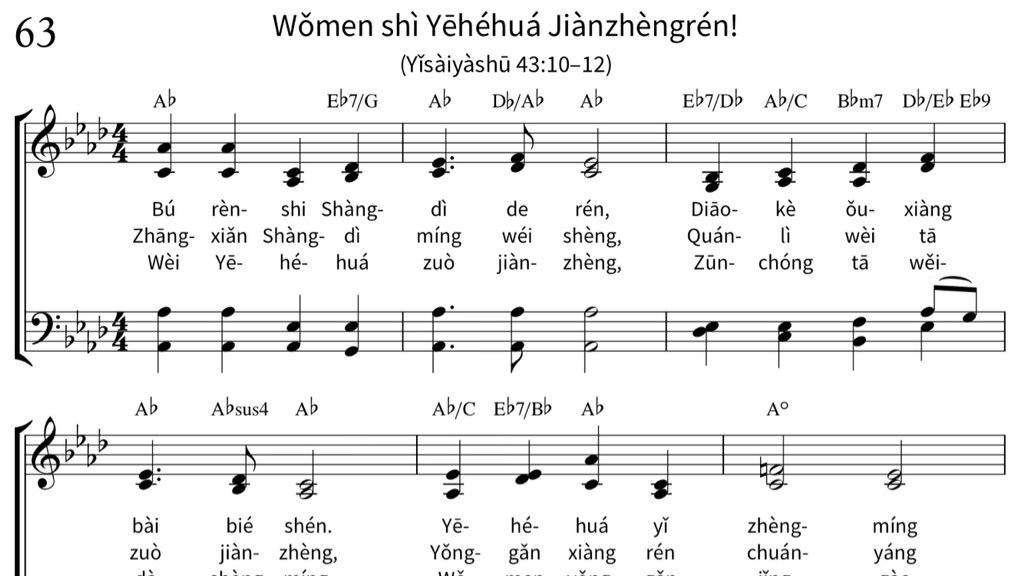“Sing Out Joyfully” Bk. Partially Proofread Pīnyīn Web Material or More Available for Songs for June 18–July 8 Mandarin Meetings
(NOTE: Re the valid general concerns expressed here about posting official publications to the Internet, there are good reasons for concluding that those concerns do not apply to this particular material. See this disclaimer for more information.)
Thankfully, an official Pīnyīn PDF file for the current songbook “Sing Out Joyfully” to Jehovah (sjj) is now available for download from jw.org. (The short link for the new songbook, tiandi.info/sjj, has been updated accordingly.) Note, however, that the currently available official Pīnyīn PDF file only contains lyrics—it does not contain musical notation.
While we greatly appreciate the official Pīnyīn songbook PDF file that is available, the PDF format itself was conceived of in a world dominated by paper. Unfortunately, that means that PDF files are often not optimal for reading on the mobile devices that are now so prevalent among Mandarin field publishers.
Also, having to share limited display real estate with Chinese characters (and, in the past, musical notation) can in certain situations force the Pīnyīn text to be rendered in small type that can be difficult to read, especially for older people.
Another difficulty that is encountered, especially when one needs to quickly find the song that is about to be sung at a meeting, is that the official meeting schedules only list the numbers of the songs to be used, and the brothers announcing what song is about to be sung often only mention the song number, but in the current official Pīnyīn songbook PDF file, there is no listing of song links in song number order.
Partially proofread Pīnyīn web material (better than auto-generated Pīnyīn like that displayed by the Equipd app, and more mobile-friendly than the older 3-line PDFs) or more for all the songs scheduled to be used during the June 18–July 8 Mandarin Our Christian Life and Ministry and “Watchtower” Study meetings has been posted to this resource that seeks to help with these challenges:
- “Sing Out Joyfully” Bk.
(Pīnyīn+Music, Pīnyīn Plus, Web)
(proofread, mobile-friendly,
links for getting around,
song links sorted by number;
Pīnyīn+Music: prezoomed to use full screen width,
easy-to-read font,
guitar chords included;
Pīnyīn Plus: flashcards integrated with the text,
carefully done human-translated
context-appropriate English translations
with literal & effective meanings,
Simplified & Traditional characters,
📖 Reveal All, 📄 Reveal Advanced, and
📘 Reveal None controls
for all the “flashcards” in a
song, paragraph, etc.,
Night Theme that can be turned on or off
using the ☀️/🌙 button at the top right,
adjustable text size)
(Info re offline viewing and printing) - Short Links:
Links ▶ Publications ▶ Books ▶
“Sing Out Joyfully” Book Links (tiandi.info/sjj)
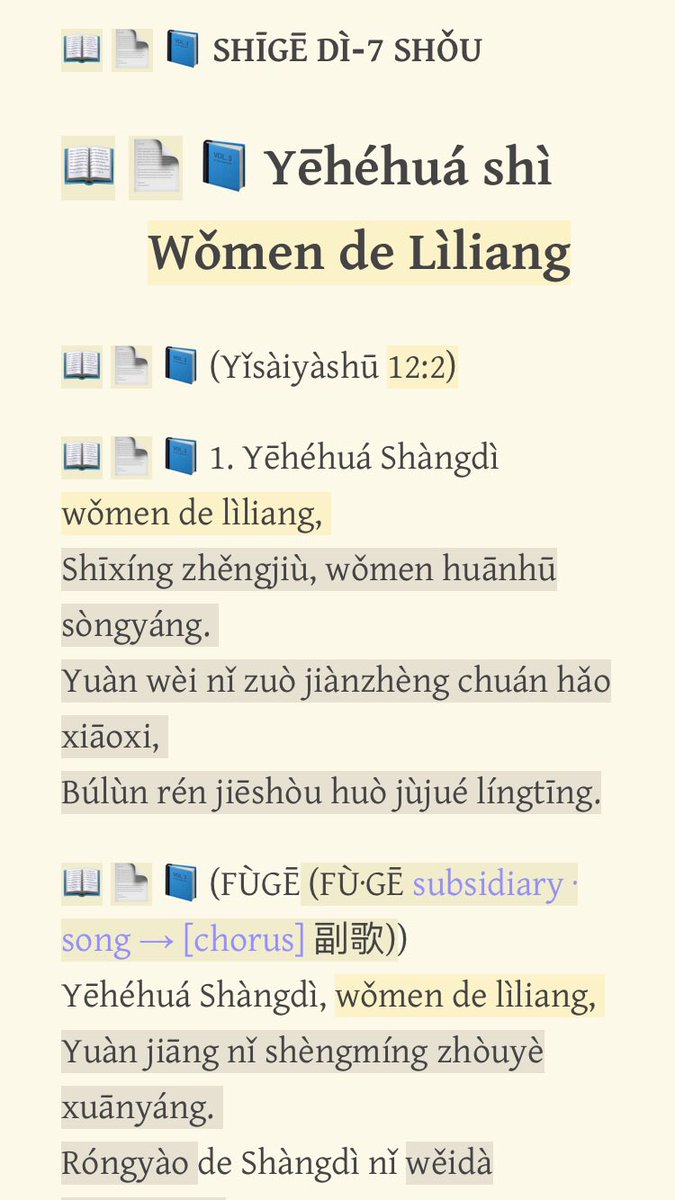
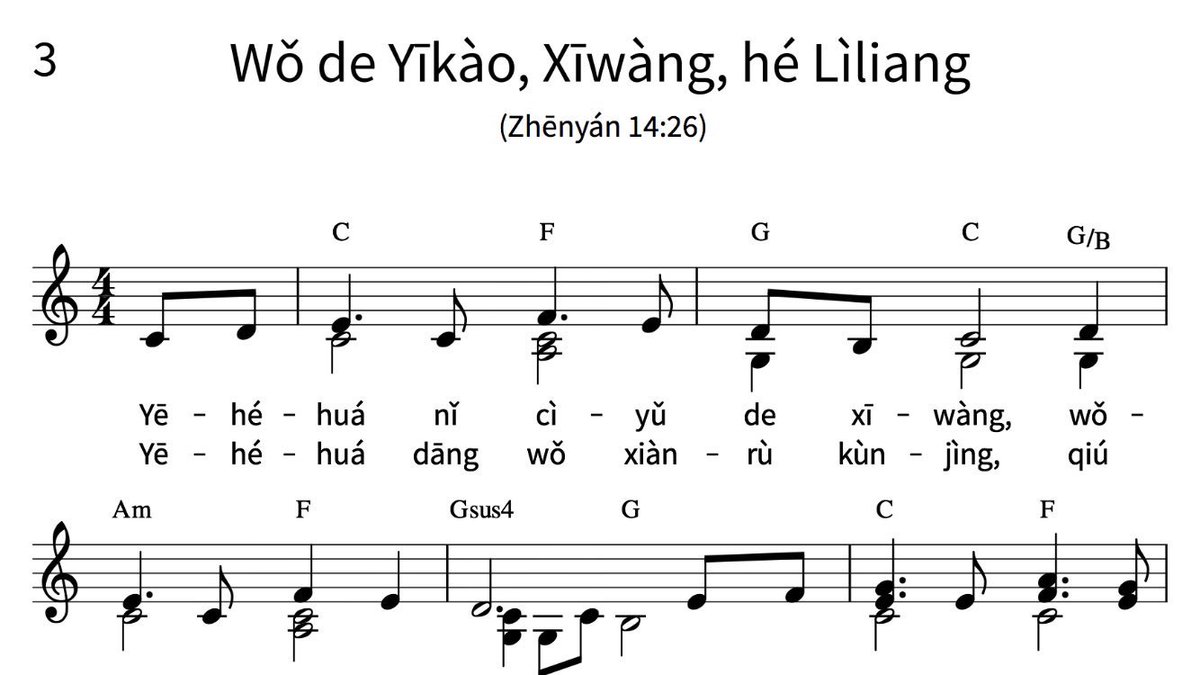
Screenshots of the above resource being used offline on an iPhone 📱, using the app GoodReader. (Other similar apps can also be used, e.g. Documents.)
Scheduling notes:
- Production of at least partially proofread Pīnyīn material (better at least than auto-generated Pīnyīn like that displayed by the Equipd app, and more mobile-friendly than the older 3-line PDFs) with a few basic Pīnyīn Plus “flashcards” is expected to keep up with all the songs scheduled for Mandarin Our Christian Life and Ministry and “Watchtower” Study meetings.
- Proofread Pīnyīn lyrics and musical notation are available for all the songs scheduled for Mandarin 2017–2018 circuit assemblies.
- Proofread Pīnyīn lyrics and musical notation are available for the songs scheduled for Mandarin 2018 Memorial meetings.
- Proofread Pīnyīn lyrics are available, and proofread musical notation is becoming available, for the songs scheduled for Mandarin 2018 regional conventions.
The Pīnyīn songbook material in the above unofficial resource has been designed to be mobile-first, so it works well on mobile devices of various shapes and sizes, including tablets and smartphones 📱. Some of the ways in which it does so are:
- Song material with musical notation 🎼 automatically loads “prezoomed” to take full advantage of the width of your device’s display, so as to render its Pīnyīn lyrics in as large a size as possible.
- In the song material with musical notation 🎼, the typeface (font) chosen for the Pīnyīn lyrics is one that is especially legible at smaller text sizes.
- The lyrics-only material uses Pīnyīn Plus technology, so the text automatically reflows according to the width of the display. Also, the text can be set to different sizes by the user, and a Night Theme is available. As time allows, more Pīnyīn Plus “flashcards” will be added, with their English translations, Chinese characters, etc.
The introduction for the above resource explains why it’s good to use Pīnyīn as a writing system on its own.
In the material with musical notation in the above resource, the Pīnyīn lyrics do not have Pīnyīn Plus “flashcard” functionality because they need to stay aligned with the musical notation. As time allows, Pīnyīn lyrics will be presented on their own as well, using Pīnyīn Plus technology. This will allow for the adding of Pīnyīn Plus “flashcards” with English translations, Chinese characters, etc. in the future.
While the original intention re the above resource was to prioritize production of material with musical notation and leave off production of Pīnyīn Plus lyrics-only material indefinitely, further analysis has led to the realization that since proofread Pīnyīn lyrics must be produced in some form for the musical notation material anyway, and since Pīnyīn Plus technology is a time-effective way to record proofread Pīnyīn text, it would be efficient to first produce proofread Pīnyīn lyrics in Pīnyīn Plus format for a particular song, and then to use those proofread Pīnyīn lyrics to speed up the production of musical notation material for that song. So, that will be the production workflow going forward for the above resource.
Previously, musical notation in the above resource was taken from screenshots of an official PDF file. Note (and make it a musical note ♪, at that 😄), though, that the musical notation for song 77 marked the debut in the above resource of musical notation 🎼 produced “from scratch” to be mobile-first in design. This should provide for better and more consistent user experiences going forward, especially on smaller mobile devices like smartphones 📱.
